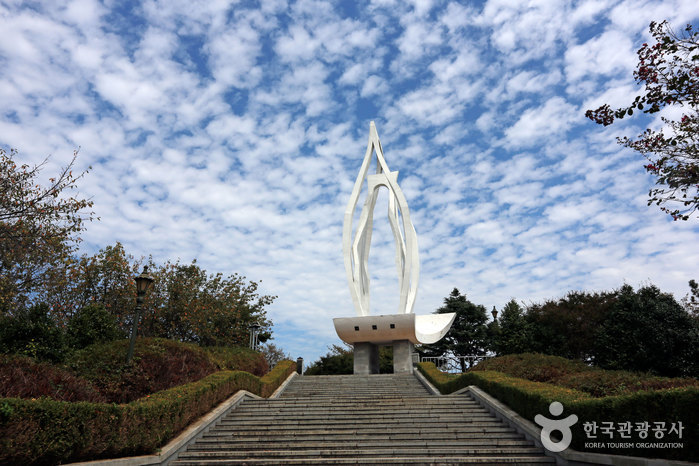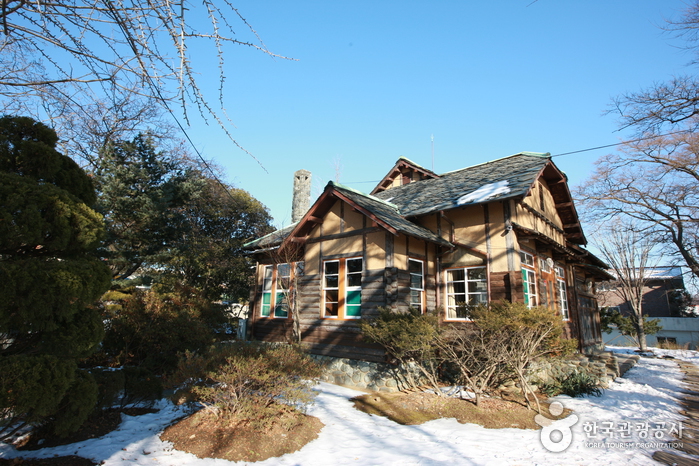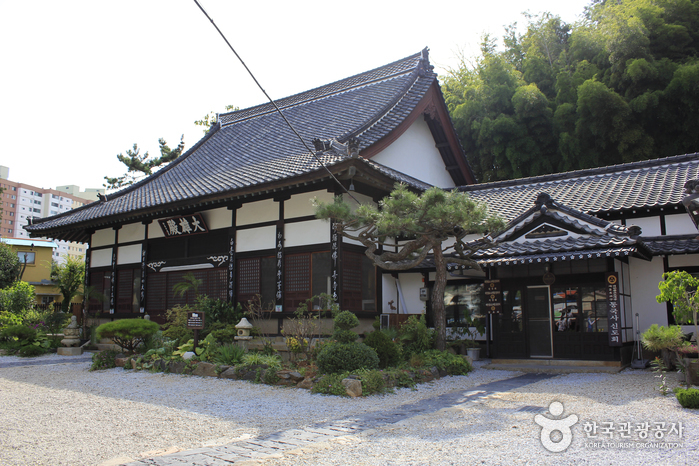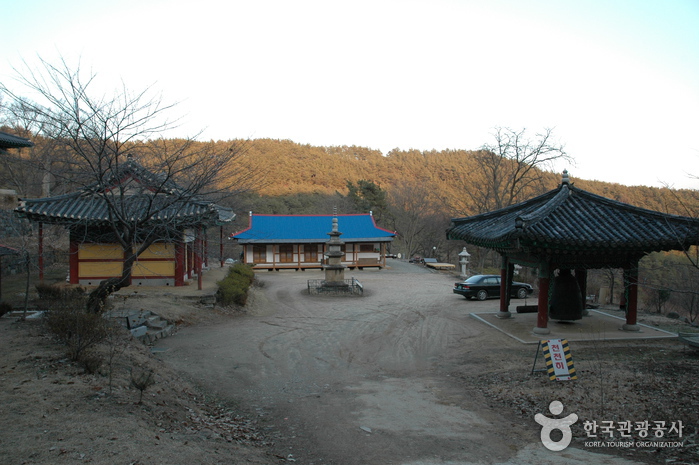Wolmyeong Park (월명공원)
13.5 Km 9007 2024-04-07
26-3, Wolmyeonggongwon 1-gil, Gunsan-si, Jeonbuk-do
+82-63-450-4000
Wolmyeong Park is a popular tourist destination in Gunsan and
connects five mountains in the vicinity. The park has 12 kilometers of walking trails, as well as an observatory, sculpture park, and various monuments. From Susi Tower, which resembles a flame or wind-blown sail, people can see all of downtown Gunsan, the sea to the south of Gunsan, the mouth of the Geumgang River, and the large Janghang smelting factory.
The park has well-arranged gardens and 30-year old rattan and cherry trees. A cherry blossom photo contest is held every April, when the park is covered in cherry blossoms.
House of Lee Young-choon (이영춘가옥)
13.6 Km 28660 2024-04-07
7, Donggaejeong-gil, Gunsan-si, Jeonbuk-do
+82-63-454-3922
The House of Lee Young-choon was constructed by
a Japanese landlord named Kumamoto during the Japanese colonial era. The house combined Western, Korean, and Japanese into one structure. After Korean liberation, Dr. Lee Young-choon, the first medical doctor, lived in the house. From that time, the house was referred to as the
House of Lee Young-choon.
Thanks to its beautiful exterior, the house was used as a backdrop for films such as Bingjeom, Sandglass, and Yain Shidae, etc.
The doctor was considered the Korean "Albert Schweitzer", and his
pen name of "Ho", referring to ssangcheon,
means "two branches of spring water, represents one for healing physical disease and the other for healing the
spirit. He was born in Yonggang-gun, Pyeongannam-do in October 1903. In 1935,
through a connection by his professor at Pyeongyanggobo School, he took a position
as the head of Jahye Hospital to take care of 20,000 people. In addition, he was the first person
in Korea to implement the policy of school nurses as well as the medical insurance union.
Dal [Korea Quality] / 달 [한국관광 품질인증]
13.6 Km 172 2024-04-07
21-2 , Guyeong 3-gil, Gunsan-si, Jeonbuk-do
+82-10-9548-3383
The Dal (‘Moon’) Guesthouse, on Modern Culture Street in Gunsan, Jeollabuk-do, is a renovated old house and offers a variety of rooms, from dormitory rooms for single travelers to private rooms for couples, families and groups. The private rooms have bathrooms and TV. Sandwiches, fruit and coffee are provided free of charge in the morning at the 1st floor cafe, and there is a shared kitchen on the 2nd floor. The Japanese-style houses in Shinheung-dong, Dongguksa Temple, and Chowon Photo Studio are all within a 2-3 minute walk.
Japanese-style House in Sinheung-dong (Hirotsu House) (군산 신흥동 일본식가옥(히로쓰 가옥))
13.6 Km 42128 2024-04-07
17, Guyeong 1-gil, Gunsan-si, Jeonbuk-do
+82-63-454-3315
Japanese-style House in Sinheung-dong was designated as Registered Cultural Heritage in 2005. The area of Sinheung-dong, where the Hirotsu House is located, was a residential area for the wealthy class during the Japanese occupation period. The house is named after Hirotsu, the man who built the house.
Several Korean movies and dramas such as "The General’s Son (1990)," Fighter in the Wind (2004)," and "Tazza: The High Rollers (2006)" were filmed in this house. The house is a typical Japanese two-story timber house, keeping the original forms of its roof, outer walls, inside area and the Japanese-style garden which has significant meaning in regards to the architecture history.
Ilchurok (일출옥)
13.7 Km 4857 2024-04-07
22-3 Guyeong 6-gil, Gunsan-si, Jeonbuk-do
063-443-5524
Ilchurok is a rice soup restaurant that specializes in two dishes: Aukguk (curled mallow soup) and kongnamul gukbap (bean sprout and rice soup). Aukguk is a popular dish made with curled mallow, raw shrimp, and homemade soybean paste. On the other hand, the kongnamul gukbap is a Jeollado-style rice soup prepared with anchovies and various ingredients for the broth. They also offer homemade kimchi and crunchy diced radish kimchi, which complement the meal well. Ilchurok operates from the early hours of the morning and offers affordable prices.
Gunsan Dongguksa Temple (동국사(군산))
13.9 Km 16076 2024-04-07
16, Dongguksa-gil, Gunsan-si, Jeonbuk-do
+82-63-462-5366
Dongguksa Temple was built by Japanese monk Seoneungbulgwan in 1909. The temple was run by Japanese monks for 36 years during the Japanese occupation, reverting to Korean jurisdiction when Korea was liberated in 1945. The historical temple is the only surviving Japanese-style temple in the nation.
The temple is characterized by its two main buildings, Daeungjeon Hall and Yosachae, which are connected by a corridor, and the temple’s relative lack of decoration, which stands as a sharp contrast to the brilliantly-colored Korean temples. Dongguksa Temple was officially designated as Cultural Asset in July 2003 and is now a branch temple of Seonunsa Temple in Gochang, the 24th district of the Korean Buddhist Jogye Order.
Bokseongnu (복성루)
14.0 Km 9333 2024-04-07
382 Wolmyeong-ro, Gunsan-si, Jeonbuk-do
+82-63-445-8412
Bokseongnu is one of the top three jjamppong (spicy seafood noodle soup) restaurants in the Gunsan area. Its specialty lies in its flavorful jjamppong broth, made with fresh squid, mussels, cockles, and vegetables. Another popular menu item is the mul jjajang (black bean sauce noodles in broth), prepared by slicing various vegetables and seafood and adjusting the thickness with starch.
Top Cloud Hotel [Korea Quality] 탑클라우드호텔 군산[한국관광 품질인증]
14.8 Km 0 2024-04-07
150-13, Beonyeong-ro, Gunsan-si, Jeonbuk-do
+82-63-452-4404
Top Cloud Hotel is in downtown Gunsan. The hotel offers good value at a reasonable price. Guestrooms are equipped with premium beds and luxury bedding, and are managed and cleaned to the highest standard. There is a large parking lot for guests’ use.
Daejosa Temple (Buyeo) (대조사 (부여))
15.1 Km 20717 2020-01-08
112, Seongheung-ro 197beon-gil, Imcheon-myeon, Buyeo-gun, Chungcheongnam-do
+82-41-833-2510
Below Seongheungsanseong Fortress (built in 501 during the Baekje Kingdom) in Buyeo is an ancient temple called Daejosa (great bird temple). Inside the temple grounds stands a giant standing stone Buddha statue looking toward the east. The temple, which was founded during the 5th year of the Baekje Kingdom, has an interesting legend behind its origin.
According to the legend, an old monk fell asleep after praying under a large rock on the slopes of Seongheungsan Mountain. In his dream, a large bird glowing in gold flew in from the west and sat on the rock where Daejosa currently stands. While the bird continuoulsy flapped its wings, a ray of light shone on the rock and it was there that the statue of Avalokitasvara Bodhisattva appeared.
The old monk had the same dream at the same time for many days. He recounted his dream to the seongju (castle lord), who then reported it to King Seong of Baekje. The king interpreted the dream as a sign that it was the right time to move the capital of Baekje to Sabi (now Buyeo) and ordered the construction of a large temple at the location that appeared in the dream. The temple was so big that even at a hurried pace, it would still take 10 years to build. Workers had to work day and night, and every time the workers felt tired, birds would come singing to brighten up the atmosphere so that the workers can forget the fatigue and continue working. Hence, the temple was completed after only five years. Because of the golden bird, the temple was named Daejosa, literally meaning "temple of a great bird."
The rock on which Avalokitasvara Bodhisattva appeared in the dream was recreated as a stone statue of a Buddha. This standing stone Maitreya Bodhisattva statue is a fine work of sculpture which, along with the stone Bodhisattva of Gwanchoksa Temple (Treasure No. 218), is a representative heritage of the early Gorye period.
In front of Wontongbojeon Hall (a hall enshrining Avalokitasvara Bodhisattva) stands a pagoda. In the old days, the stone pagoda used to have only the cover stones but as the pagoda body stones were found, the structure was completely restored in 1975. This pagoda is assumed to have been built in the early days of the Goryeo Kingdom.
Himart - Susong Branch [Tax Refund Shop] (하이마트 수송점)
15.3 Km 0 2024-06-27
237, Wolmyeong-ro, Gunsan-si, Jeollabuk-do
-


![Dal [Korea Quality] / 달 [한국관광 품질인증]](http://tong.visitkorea.or.kr/cms/resource/35/2652935_image2_1.jpg)


![Top Cloud Hotel [Korea Quality] 탑클라우드호텔 군산[한국관광 품질인증]](http://tong.visitkorea.or.kr/cms/resource/96/2949296_image2_1.jpg)

![Himart - Susong Branch [Tax Refund Shop] (하이마트 수송점)](http://tong.visitkorea.or.kr/cms/resource/32/3314432_image2_1.jpg)
 English
English
 한국어
한국어 日本語
日本語 中文(简体)
中文(简体) Deutsch
Deutsch Français
Français Español
Español Русский
Русский